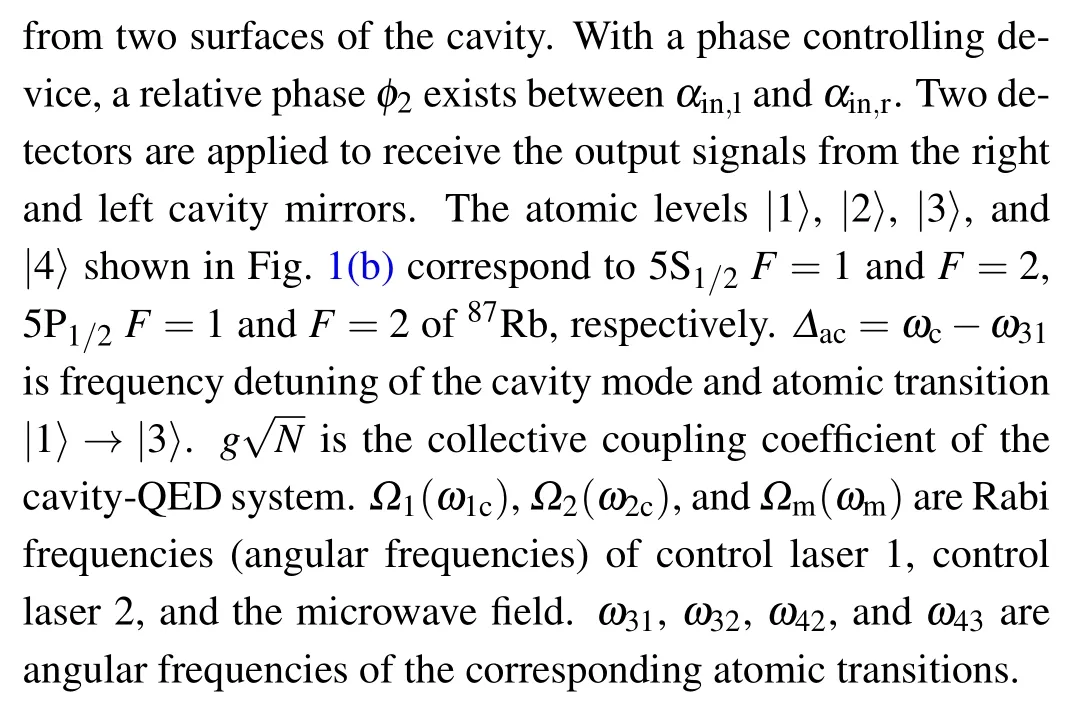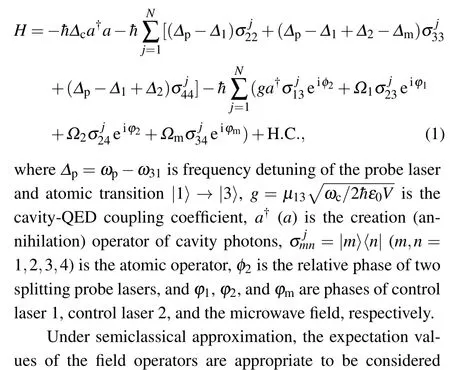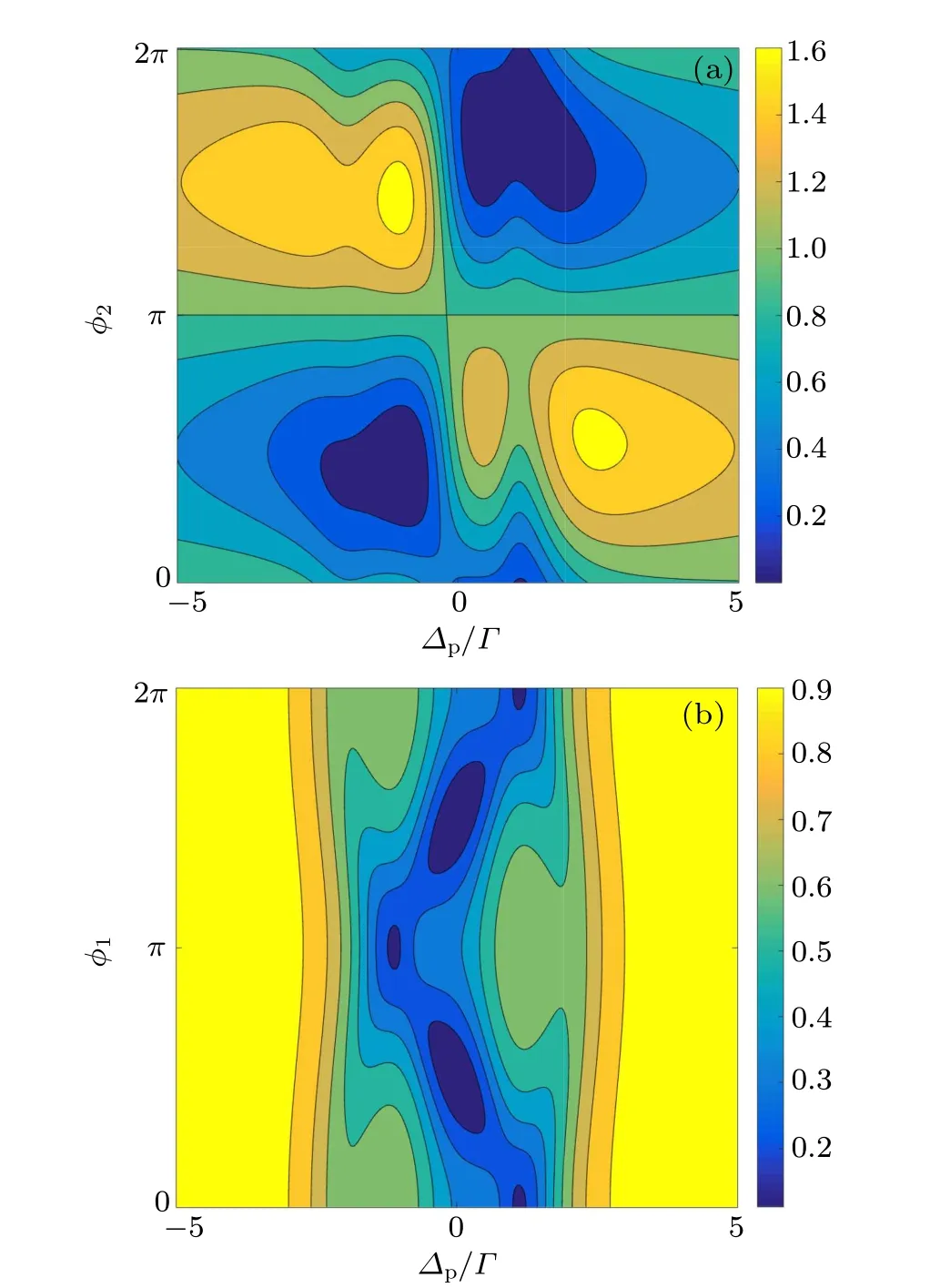Absorption interferometer of two-sided cavity*
Miao-Di Guo(郭苗迪) and Hong-Mei Li(李红梅)
1School of Sciences,Xi’an Technological University,Xi’an 710021,China
2College of Electronic Science and Engineering,Jilin University,Changchun 130012,China
Keywords: cavity quantum electrodynamics(QED),optical switching,quantum interference
1. Introduction
Optical interference is a direct evidence for wave theory of light, based on which many precise instruments and technologies have been developed, e.g., Michelson interferometer,Mach–Zehnder interferometer,interferometry,and holography. With the development of quantum mechanics and cavity quantum electrodynamics(cavity-QED),quantum interference,which is based on the uncertainty of different transition channels, is becoming more and more important in the interaction of light and matter. One famous phenomenon of quantum interference is electromagnetically induced transparency(EIT),[1–3]which can be used to realize light switching.[4–9]When an EIT system has a closed interaction loop, it shows phase-dependent property.[10–14]This brings a more sophisticated way of manipulating optical fields. In addition, some studies, such as beam splitter[15]and entanglement between collective fields,[16]are based on phase-dependent EIT. By controlling the phase shift of input lasers in atomic system,one can operate the nonadiabatic optical transitions and quantum mechanical superposition states.[17,18]With the aid of Kerr cross-phase modulation, one can also realize the polarization selection in EIT medium.[19,20]Besides quantum interference,phase shift also plays a vital role in traditional optical interference. Putting wave interference together with quantum system, the manipulation of optical absorption can reach a new era.[21–23]
Here we propose a scheme to manipulate optical intensity in cavity-QED system via phase controlling devices. Using the closed interaction loop and two coherent incident beams,we manipulate the field intensity through the interaction of medium absorption and wave interference. Intracavity field and output field can be periodically modulated by a relative phase and two output channels can be operated at the same pace or at fixed pace delay versus the relative phase. We make theoretical analysis of this cavity-QED system and obtain the solutions for intracavity field and output fields, respectively.We also explain the principle for our scheme to be implemanted as an absorption interferometer and an optical switching based on phase modulation in Section 2. The detailed theoretical simulated results are presented in Section 3. At last,we make a simple summary in Section 4.
2. Theoretical analysis



Fig. 1. (a) Theoretical scheme and (b) four-level atomic energy-level structure of 87Rb.
Under rotating wave approximation, the Hamiltonian of this scheme is as follows:


where

3. Results



Fig.2. Contour plots of Irout as a function of frequency detuning ∆p and(a)relative phase φ2,(b)closed-loop phase φ1. The parameters are(a)φ1=0 and(b)φ2=0.
Here we choose three representative frequencies ∆p=−Γ, ∆p=0, and ∆p=Γ to analyze the phase controlling on the output field intensity. We show the contour plots of output field intensity Iroutversus φ1and φ2in Fig.3. They present the symmetry about φ1which is the same with that shown in Fig.2(b)for three frequency detunings above. While the situation for φ2=0 →π is very different from that for φ2=π →2π, it shows the frequency relevance of the optical interference.When it is at negative frequency detuning as in Fig.3(a),the photon-escape enhancement appears at φ2=π →2π. Increasing absorption causes the decreasing of the output intensity with changing φ1from 0 to π (or from 2π to π.) When∆p=0 (Fig. 3(b)), the enhancement of the output intensity disappears and the maximum output intensity appears around φ2=π.This is because the closer to φ2=π,the closer to Ic=0 as indicated in Eq.(5),namely,φ2=π is the condition of perfect transmitter/reflector. According to Fig.2(b), it is easy to understand why the maximum output intensity for ∆p=0 appears at φ1≈0, π, and 2π respectively. While for positive frequency detuning as in Fig. 3(c), the output enhancement occurs when φ2is 0 →π and the enhancement is weakening with φ1=π →0 or φ1=π →2π which is opposite to the results in Fig.3(a). For φ2=0 →2π,Fig.3 presents a remarkable sign of optical interference and the interference fringes become more similar with general fringes when the probe frequency is non-resonant with atomic transition|1〉→|3〉. The nonuniform intensity distribution of the interference fringes is due to the nonlinear absorption and multiple diffraction of the input light and transmission(reflection).[28]
Since the output spectra are always symmetrical about φ1=π no matter what the probe frequency is,we modify the closed-loop-phase device to make φ1=0,π/2,π in turn,then we analyze the intensity of the intracavity field and the output fields from the right and left mirrors for both resonant and nonresonant frequencies.The results are shown in Fig.4.Here we present the result for φ1=π/2 in consideration that the varying tendencies for φ1=0 and φ1=π are similar with that for φ1=π/2 except one phenomenon that Irout=Iloutfor the whole range of φ2(0 →2π)at ∆p=0 as shown in Fig.4(a). The situation for negative frequency detuning is not presented here,because the only difference is that the output field from the right(left)mirror for negative frequency detuning has a fixed pace delay with the situation for positive frequency detuning.In Fig. 4, when φ2=π, the perfect transmitter/reflector condition is satisfied. Therefore, the intracavity field intensity is always zero,the output field intensity from the right mirror is the same as that from the left mirror and the total output intensity ratio is always the maximum value 2,which manifests the frequency independence as well as medium irrelevance of field intensity for φ2=π.







Fig.5.With probe frequency tuned with atomic transition|1〉→|3〉(∆p=0),the field intensity ratio versus closed-loop phase φ1 for(a)φ2=0,(b)φ2=π/2,and(c)φ2=π. The other parameters here are the same as those in Fig.3.
4. Conclusions
At the threshold of strong collective-coupling regime,the optical field intensity of a four-level atom-cavity system is analyzed. Due to the closed loop, there will be a relative phase φ1between three control fields in susceptibility of the atomic medium, thus the intracavity field and output fields are manipulated by controlling the medium absorption via φ1. Since two coherent input beams are applied with relative phase φ2,the analytical solutions for both intracavity field and output fields contain two phase factors φ1and φ2. Therefore,besides the absorption controlling by closed-loop phase φ1, the optical interference dependent on relative phase φ2is applied to manipulate the field intensity.
Via the contour plots versus φ1and φ2,the interaction of medium absorption and wave interference is analyzed,and an absorption interferometer based on phase modulation is proposed. In this scheme, the switching between perfect transmitter/reflector and non-perfect CPA is realized in theory.And the pace delay on φ2between Iroutand Iloutprovides us a way to fulfill frequency filtering. By controlling closed-loop phase φ1,the intracavity field can be modulated periodically. Therefore the scheme proposed here can be applied to operate light field more delicately in cavity-QED system.
- Chinese Physics B的其它文章
- Corrosion behavior of high-level waste container materials Ti and Ti–Pd alloy under long-term gamma irradiation in Beishan groundwater*
- Degradation of β-Ga2O3 Schottky barrier diode under swift heavy ion irradiation*
- Influence of temperature and alloying elements on the threshold displacement energies in concentrated Ni–Fe–Cr alloys*
- Cathodic shift of onset potential on TiO2 nanorod arrays with significantly enhanced visible light photoactivity via nitrogen/cobalt co-implantation*
- Review on ionization and quenching mechanisms of Trichel pulse*
- Thermally induced band hybridization in bilayer-bilayer MoS2/WS2 heterostructure∗

